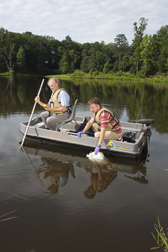A Better Way To Track Salmonella and E. coli in Waterways
A team of Agricultural Research Service scientists at the J. Phil Campbell Sr. Natural Resource Conservation Center in Watkinsville, Georgia, has come up with a way to detect both Salmonella and pathogenic (disease-causing) E. coli in waterways at lower levels than any previous method could. Similar methods have been developed to detect pathogenic E. coli in meat products, but the team’s approach represents a first for waterways.
When health officials test a public beach or a lake for Salmonella or E. coli O157:H7 as part of a routine inspection, they test for the presence of two types of nonpathogenic bacteria—Enterococci and generic E. coli—as indicators of the presence of the pathogens. They do this because the pathogens themselves are hard to detect directly at the low levels that can make someone sick: Just 100 cells of Salmonella or 10–100 cells of E. coli O157:H7 can cause illness.
The bacterial indicators are commonly found in the intestines of warm-blooded animals. But while they are often detected in contaminated waterways, their abundance doesn’t guarantee the presence of either pathogen, says Michael Jenkins, a microbiologist at the ARS center. Investigators have detected the indicators in pathogen-free waters and failed to find them in waters with sufficient levels of the pathogens to make someone sick.
Salmonella and E. coli outbreaks are often attributed to agricultural operations, so improving the methods for tracking down sources of outbreaks is a major priority. “Our goal is to be able to use the pathogens themselves in assessing the contamination, instead of the indicator organisms,” Jenkins says.
Jenkins and his ARS colleagues Dinku Endale and Dwight Fisher combined techniques previously developed to assess water quality and detect pathogens in laboratory settings: a water-filtration technique to concentrate the pathogens; a special medium for growing and measuring the number of pathogenic cells; a biochemical testing process; and PCR (polymerase chain reaction) technology, a molecular identification technique often used to increase or magnify a small sample of DNA.
They collected water samples from different points in a pond at the Watkinsville site, ran them through a special filter, removed the filter contents, and used a centrifuge to spin the filtered contents into a pellet form. They cultured the pellets to ramp up the amount of pathogens found in the original samples. To confirm the presence of the pathogens at the molecular level, they used PCR technology. As a control measure, they ran sterile water through the system and used some water samples spiked with pathogenic E. coli and Salmonella to test the filtration system.
The results showed that the process is able to detect just a few cells of pathogenic E. coli and Salmonella in 10-liter water samples, lower levels than any previously detected. The work, published in two papers in the Journal of Applied Microbiology, is a significant step toward improving the methods used by federal, state, and local agencies to track down the sources of outbreaks of Salmonella and pathogenic E. coli. Because the system involves cell cultures, it should lead to developing culture collections that, like a fingerprint database, could be used to identify bacterial strains and sources of future outbreaks.
“The sensitivity of this method will enhance our understanding of the fate and transport of these pathogens in agricultural watersheds, and it should prove helpful in identifying the sources of these pathogens in the environment,” Jenkins says.—By Dennis O'Brien, Agricultural Research Service Information Staff.
This research is part of Manure and Byproduct Utilization, an ARS national program (#206) described at www.nps.ars.usda.gov.
Michael Jenkins is with the J. Phil Campbell Sr. Natural Resource Conservation Center, 1420 Experiment Station Rd., Watkinsville, GA 30677; (706) 769-5631.
"A Better Way To Track Salmonella and E. coli in Waterways" was published in the February 2011 issue of Agricultural Research magazine.








